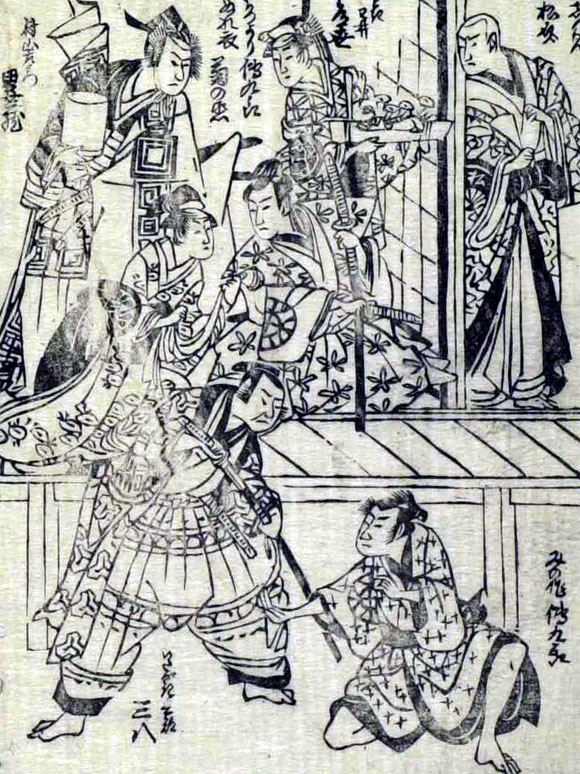| SHINGEN YAKATA |
| Play title | Honch˘ Nijűshik˘ |
||||||||||||
| Authors | Chikamatsu Hanji Miyoshi Sh˘raku Takeda Inaba Takeda Heishichi Takemoto Saburobŕ II |
||||||||||||
| History |
The play "Honch˘ Nijűshik˘" was originally written for the puppet theater (Bunraku) and staged for the first time in the 1st lunar month of 1766 in ďsaka at the Takemotoza. It was adapted for Kabuki a few months later and was produced by both Nakamura Utaemon I and Mimasu Daigor˘ I in ďsaka at the Naka no Shibai [casting]. |
||||||||||||
| Structure |
"Shingen Yakata" ("Shingen's Mansion" in English) is the common nickname for the last scene of the 2nd act of "Honch˘ Nijűshik˘". The regular title is "Takeda Shingen Yakata Seppuku" ("the seppuku in Takeda Shingen's Mansion") or "Takeda Shingen Yakata Katsuyori Seppuku" ("Katsuyori's seppuku in Takeda Shingen's Mansion"). This 1-hour long scene is occasionnally revived within a t˘shi ky˘gen production of "Honch˘ Nijűshik˘". Here is the list of all performances from the end of WWII to the end of the 20th century:
|
||||||||||||
| Key words | Gidayű Ky˘gen Giri/Ninj˘ Takeda Shingen Takeda Katsuyori Seppuku J˘shi Yakata |
||||||||||||
| Summary |
In the garden of Shingen's mansion two servants (yakko), Kakusuke and Hakubei, talk about what they suspect to be a serious problem of their master's family. Nureginu, who has returned from her visit to the Suwa My˘jin Shrine, overhears their conversation and feels relieved to learn that they have no accurate knowledge of the trouble. She tells them to stop talking and go to the kitchen if they have finished sweeping the garden. Nureginu reports to Shingen's wife, Lady Tokiwai, on the ribbon she has brought back from the Suwa My˘jin Shrine, saying that it augurs well for Katsuyori. Lady Tokiwai says that Itagaki Hy˘bu has gone to look for a substitute for Katsuyori and is expected to come back at any moment. Murakami Yoshikiyo comes as a messenger (j˘shi) from the Shogunate government to demand the fulfillment of Shingen's promise to kill his son Katsuyori. In reply Lady Tokiwai falsely tells him that, because Katsuyori was born as a result of her prayer at the Suwa My˘jin Shrine, she has sent a messenger to the shrine to ask for its permission to kill him. She appeals to Yoshikiyo to wait until the messenger returns. Yoshikiyo picks a morning glory in the garden and, putting it in a vase, says to Lady Tokiwai that he will wait until the morning glory withers. Overhearing the conversation between Yoshikiyo and Lady Tokiwai, Katsuyori, who is blind, makes up his mind to kill himself. Nureginu, surprised, tries to dissuade him when Lady Tokiwai advises them to marry and flee as man and wife. Before they can do so, however, Yoshikiyo tells Katsuyori that he will put him to death as the morning glory has withered. Katsuyori disembowels himself and Yoshikiyo cuts off his head. Hy˘bu arrives with a palanquin carrying Minosaku, whom he plans to use as Katsuyori's substitute. As soon as the two palanquin bearers put the vehicle on the ground Hy˘bu kills them with his sword. When told by Lady Tokiwai that he has come back too late, Hy˘bu stamps with chagrin. After Yoshikiyo has left, carrying Katsuyori's severed head, Hy˘bu tries to kill Minosaku but is fatally stabbed by Shingen. Shingen reveals that the blind Katsuyori was in fact Hy˘bu's son, who closely resembled Katsuyori, and that Minosaku is in fact his own son Katsuyori. Soon after they were born 17 years before, Hy˘bu secretly exchanged them, wishing to make his son Shingen's heir. Shingen soon discovered the exchange but has pretended ignorance, not telling the truth to anyone, even to his wife. He says that Hy˘bu, by pretending to save the life of his master's son, actually tried to kill him and save the life of his own son. Nureginu tries to kill herself but is interrupted by the dying Hy˘bu, who suggests to her to help recover Shingen's helmet named H˘ssh˘, which is now held by Kenshin. Minosaku, who is real Katsuyori, says he will continue his disguise as Minosaku to make the Shogunate government believe that Katsuyori was actually killed. Source: Hironaga Shűzabur˘ |
 |
|
Top part of the picture: the actors Ichikawa Omez˘ I (top/left), Segawa Kikunoj˘ III (bottom/left), Nakamura Denkur˘ IV (bottom/right), Osagawa Tsuneyo II (top/center) and Onoe Matsusuke I (top/right) playing the roles of the j˘shi Murakami, the koshimoto Nureginu, Takeda Katsuyori, the okugata Tokiwai and Takeda Shingen in the "Shingen Yakata" scene of the drama "Honch˘ Nijűshik˘", which was staged in the 5th lunar month of 1799 at the Ichimuraza Bottom part of the picture: the actors Arashi Sanpachi I (left) and Nakamura Denkur˘ IV (right) playing the roles of Itagaki Hy˘bu and Minosaku in the same drama |
|
|
| Contact | Main | Top | Updates | Actors | Plays | Playwrights | Programs | Links | FAQ | Glossary | Chronology | Illustrations | Prints | Characters | Derivatives | Theaters | Coming soon | News |